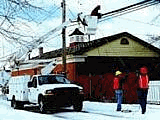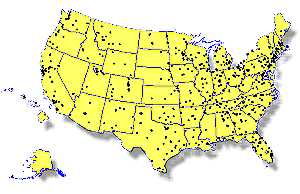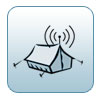ATEK Communications-
Wireless- WIFI- Backhaul Data Services
National Wireless Networks-National WIFI Installation-National WIMAX Installation-National Point to Point Wireless Installations- NationalPoint to Multipoint Wireless Installations
 All
of ATEK Communications offices are part of a nationwide team of wireless network installation
personnel can be mobilized anytime, anywhere to install your National Wireless Networks, National WIFI Installation,National WIMAX Installation, National Point to Point Wireless Installations, NationalPoint to Multipoint Wireless Installations.It is widely deployed in public areas know as hotspots as for Internet cafes like Starbucks- Panera Bread , campus environment, airports, hotels) and residential, multi-tenant buildings and enterprise where it’s used as an alternative to a wired LAN. WiFi brings the Internet to users with wireless laptops or PDAs and soon to cell phones regardless of their location. ATEK Communications now can provide you with Mesh Networks that can seamlessly provide owners of hotels and resorts.
All
of ATEK Communications offices are part of a nationwide team of wireless network installation
personnel can be mobilized anytime, anywhere to install your National Wireless Networks, National WIFI Installation,National WIMAX Installation, National Point to Point Wireless Installations, NationalPoint to Multipoint Wireless Installations.It is widely deployed in public areas know as hotspots as for Internet cafes like Starbucks- Panera Bread , campus environment, airports, hotels) and residential, multi-tenant buildings and enterprise where it’s used as an alternative to a wired LAN. WiFi brings the Internet to users with wireless laptops or PDAs and soon to cell phones regardless of their location. ATEK Communications now can provide you with Mesh Networks that can seamlessly provide owners of hotels and resorts.

 Please visit our partners-
Please visit our partners-
ATEK Communications will provide you targeted wireless solutions based on your requirements and your budget. ATEK will assist you first in determining your specific wireless needs as far as speed, bandwidth, coverages and performance- and your budget. The we will work with you in determining your growth requirements and work with you and your budget to "future -proof" your network insuring years of trouble -free performance.
- National Wireless Roll Outs
- National Wireless Hospitality Roll Outs
- Municipality Wireless Roll Outs-Projects
- National Wireless Chain Store Roll Outs
- National Wireless Projects -802.11 (WiFi) and 802.16 (WiMax) and proprietary
- Regional Wireless Projects-802.11 (WiFi) and 802.16 (WiMax) and proprietary
- Triple-Play- FTTH- Wireless Combo's- 802.11 (WiFi) and 802.16 (WiMax) and proprietary
All ATEK Communications offices are part of a nationwide team of network installation personnel can be mobilized anytime, anywhere. These experts are backed by seasoned teams of administrators, project managers, and technicians who are equipped to handle virtually any project. Established relationships with leading vendors also assure the best possible service and quality equipment is provided to our customers. These experts are backed by seasoned
teams of administrators, project managers, and technicians who are equipped to
handle virtually any project. Laptops and competition between Internet Service Providers (ISPs) have resulted
in an increased focus on the use of RF technologies to provide data access
services. Whether you desire to web surf from your laptop while enjoying a cup
of espresso at the local coffee house or a business looking for ways to reduce
Internet access fees, you are likely asking the question, "Can I do this wirelessly?" Most laptops today come equipped with wireless network connections. However, these wireless network connections are useless unless there is a wireless service available. Laptop computers now face the same problem that cell phones face: Where's the signal?
 We offer a complete array of wireless-WIFI Product Solutions
We offer a complete array of wireless-WIFI Product Solutions
All ATEK Communications offices are part of a nationwide team of network installation personnel can be mobilized anytime, anywhere. These experts are backed by seasoned teams of administrators, project managers, and technicians who are equipped to handle virtually any project. Established relationships with leading vendors also assure the best possible service and quality equipment is provided to our customers. These experts are backed by seasoned
teams of administrators, project managers, and technicians who are equipped to
handle virtually any project. Laptops and competition between Internet Service Providers (ISPs) have resulted
in an increased focus on the use of RF technologies to provide data access
services. Whether you desire to web surf from your laptop while enjoying a cup
of espresso at the local coffee house or a business looking for ways to reduce
Internet access fees, you are likely asking the question, "Can I do this wirelessly?" Most laptops today come equipped with wireless network connections. However, these wireless network connections are useless unless there is a wireless service available. Laptop computers now face the same problem that cell phones face: Where's the signal?
 Temporary WIFI Networks
Temporary WIFI Networks  Metro-Rural Networks
Metro-Rural Networks  Hospitality
Hospitality Enterprise
Enterprise
Internet access for companies has traditionally been provided through special phone company circuits called T1s (or E1s). But local exchange companies (LECs) have traditionally held service monopolies in their markets and as a result T1/E1 service had no competition … if you wanted high speed Internet access, you had to pay the high monthly T1 lease fees. However, competition in the phone industry has been established and as a result, competing ISPs, CLECs, WISPs, etc. have been deploying their own networks (including wireless portions) from which to offer data networking services such as high speed access as well as plain old telephone service (POTS).
As you can see, there are several markets to be served by the wireless Internet Service Provider industry (WISP). No one product can serve all the myriad of applications and as a result there are now several wireless technologies to choose from. These technologies fall into two categories: standard technologies such as 802.11 (WiFi) and 802.16 (WiMax) and proprietary technologies. Each technology has its own advantages and disadvantages. But this is not the only way to distinguish wireless technologies. Other technology differences have to deal with whether the technology is point-to-point (PTP), point-to-multipoint (PMP), or something else (ex: mesh). Each of these faces differing regulatory requirements and serves different purposes.
Point to Point Technologies: Data Backhauls
PTP technologies are useful for serving as data backhauls that serve distribution systems (xDSL, cable modems, etc) and for connecting private data networks (ex: office buildings). PMP technologies are useful as distribution systems since more than one "end point" (customer premise) is served by a single "start point" (basestation).
Another key difference in wireless technologies is the geographic distance they are to serve. The term "hot spot" (referring to a small geographical area of coverage … for example, a coffee house) has entered into the standard terminology of the wireless data networking industry. But equipment useful for hot spot coverage will not accommodate the needs of the "last mile" application. A bit of a misnomer, the "last mile" has progressed to mean anything from the "last 50 meters/feet" to the "last 20 miles".
Point-to-point (PTP) RF data networking refers to the use of wireless (RF) technologies to create a data link between two … exactly two … locations. PTP wireless data networks tend to require high data throughput over long distances.
PTP is different from point-to-multipoint (PMP) in two key ways. First, PMP has more than two locations. Second, because there are more than two locations all sharing the same access media (the RF channel), the control and use of the RF channel becomes more complex.
Even within the "unlicensed" RF spectrum there are still regulatory requirements placed on the RF equipment. These regulatory requirements are typically different for PTP products than for PMP (sometimes very different). Most typically, these regulatory requirements deal with limiting the strength of the RF transmission. Just to make things more complicated, these restrictions are often placed on the RF equipment itself (TX power) and also on the combined affect of the RF equipment and the RF antenna (EIRP). PTP regulatory limits are typically higher than those for PMP products.
Wireless PTP data links typically do not require much in the way of network services. As a result, PTP devices typically operate as simple (Ethernet) bridges and leave services such as routing and traffic policing to the networks they are connecting. In a sense, a PTP wireless link becomes an invisible "cable" joining two data network devices. Without wireless technology, distances of over 100 meters typically must be served by wide area network (WAN) technologies such as T1/E1 and fiber. However, wireless data networking allows for local area network (LAN) technologies such as 10-BaseT to be used. These technologies are not only less expensive but they are more readily available as well … just about every computer now has an Ethernet network interface (NIC) port. This means that computers can be directly connected to each other using wireless PTP technology even if they are separated by many miles/kilometers.
Interconnect
Services
-
Telephone
Systems- We Service Most PBX & Key Systems
-
PBX
Installation & Programming
-
Project
Management
-
Ask
Us About Our Quality -Guaranteed Refurbished Telephone Systems - Save More Than
80% Over A New Phone System

 |
 | Telecommunications
Cost Burden Audits and Cost Savings Analysis |
 |
 | Wide
Area Voice Connectivity and Data Integration Solutions |
 |
 | PBX
Systems Integration and Management |
 |
 | Voice
Over Internet Technologies and Implementation |
 |
 | Call
Center Design, Load Balancing and Software Based Management Solutions. |
 |
 | Unified
Voice Messaging and Management Solutions |
 |
 | Wiring
Infrastructure Analysis and Specifications |
 |
 | Local
Voice Service Provisioning |
 |
 | Long
Distance Voice Service Provisioning |
 |
 | Leased
Line and Data Connectivity Service Provisioning |
 |
California
Offices Northern CA (925) 944-1511
California
Offices Southern CA (760) 471-8200
Tampa
Bay Florida Offices (866) 650-DATA
(866)
650- DATA

